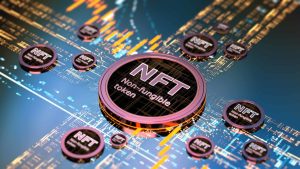Competitive games originated long before the advent of slot machines and computers. The thirst for competition has guided people since time immemorial, and with technological progress only increased. This was one of the turns of evolution of the game industry.

The second branch of evolution was the emergence and further spread of already gambling. Over time, gambling became part of the “classic” gaming industry and gave it a boost. Games like CSGO, Dota and LoL attracted hundreds of thousands of fans, and csgo gambling and other disciplines added to this number of tens of thousands of community members.
However, in the ever-evolving world of gaming, innovation knows no bounds. In 2023, the gaming industry continues to undergo a technological revolution that promises to redefine the way we think about ownership and economics in virtual worlds. At the heart of this transformation is the merging of blockchain technology and NFT (Non-Fungible Tokens).
In this article, we look at how blockchain and NFT are revolutionizing ownership and economics in gaming, paving the way for a new era of player-centric, decentralized and monetizable content gaming experiences.
Digital Asset Ownership
Traditionally, gamers have had limited control over their in-game assets. These assets, be it rare weapons, skins or even characters, were owned and controlled by game developers, leaving players with no real ownership rights. However, with the advent of blockchain and NFTs, this paradigm is changing dramatically.
NFTs represent ownership of digital assets with a unique and immutable digital signature. In the gaming world, NFTs have allowed players to truly own their in-game items. These assets are no longer limited to the confines of a single game; they can be bought, sold, and traded across multiple gaming platforms and trading platforms, crossing the boundaries of individual gaming ecosystems.
This new ownership empowers gamers by giving them the freedom to monetise their digital assets and provide tangible value for their time and effort invested in the game.
A player-driven economy
Blockchain and NFT are catalyzing the emergence of player-driven economies in virtual worlds. In traditional gaming models, in-game economies are carefully controlled by developers, often resulting in inflation, imbalance and lack of transparency. With blockchain technology, the in-game economy is decentralized and player-driven.
Players can participate in creating and regulating the rules of these economies through decentralized autonomous organizations (DAOs). DAOs allow players to make collective decisions on issues such as item rarity, item distribution, and economic policy. This shift to a player-driven economy not only increases player engagement, but also fosters a sense of ownership and responsibility.
What’s more, players can now earn real income while playing games. With the ability to buy, sell and trade NFTs, gamers now have the opportunity to turn their hobby into a lucrative endeavor. This economic paradigm shift democratizes the gaming industry, providing financial opportunities to a wider range of players.
Decentralized ownership and governance
The core principles of blockchain – decentralization and transparency – are changing the way games are managed and controlled. Smart contracts built on blockchain networks allow for automated and transparent governance processes.
For example, decisions on game updates, asset creation and even the allocation of development funds can be made via smart contracts, eliminating the need for centralised governance bodies. This ensures a fair and democraticC decision-making process, as all participants can track and verify these transactions on the blockchain.
Decentralized ownership and governance not only builds trust within the gaming community, but also allows development decisions to be made with The International heresies of players in mind, resulting in games that are more reflective of players’ wants and needs.
Monetisation and content creation
One of the most heresy aspects of the International integration of blockchain and NFT in the gaming industry is the ability for creators and gamers to monetise their content and creativity. Content creators, streamers and artists can mine their unique NFTs tied to in-game assets, merchandise or exclusive experiences.
Players who excel in a particular game can monetise their skills by selling rare in-game items, character customisation or even their accounts as NFTs. This opens up new revenue streams for professional gamers and enthusiasts alike, contributing to a more diverse and inclusive gaming ecosystem.
In addition, blockchain technology enables fair revenue sharing mechanisms through smart contracts, ensuring that creators receive a fair share of the profits generated by their content and contributions. This incentivises innovation and quality in the gaming industry, ultimately bringing players a richer and The International ereader experience.
Conclusion
In the ever-changing gaming landscape, blockchain and NFT have become a disruptive force that has changed the ownership, economics and player participation in virtual worlds. The shift from developer-controlled assets to player-owned NFTs provides gamers with new opportunities for autonomy and economics.
Player-driven economies and decentralised governance models foster a sense of community and transparency that was previously unheard of in the gaming industry. The ability to monetise content and in-game assets empowers gamers and creators alike, paving the way for a more inclusive and financially rewarding gaming ecosystem.
As The International approaches 2023, the integration of blockchain and NFT in the gaming industry could lead to even more innovative and transformative changes. Gamers can look forward to a future where they not only play games, but also co-create and thrive in the virtual worlds they inhabit. This revolution is a testament to the limitless potential of technology and the gaming community’s unwavering commitment to exploration and innovation.